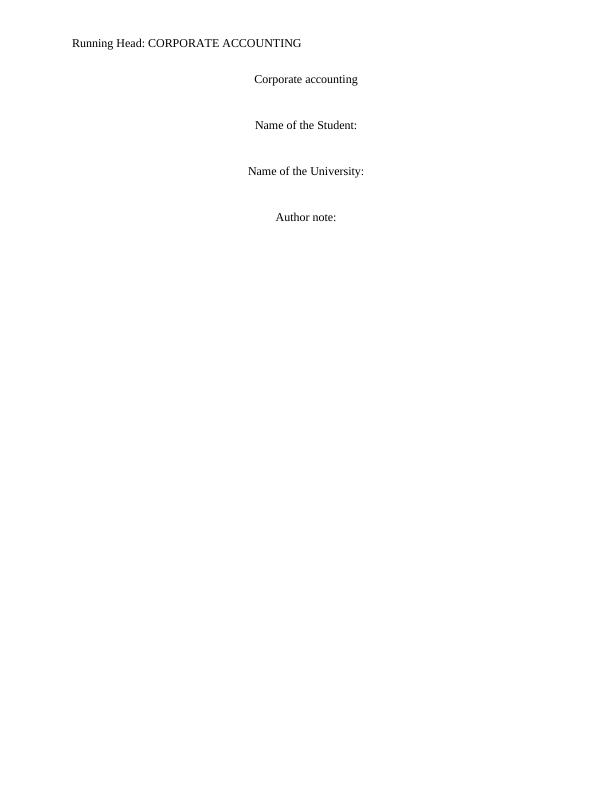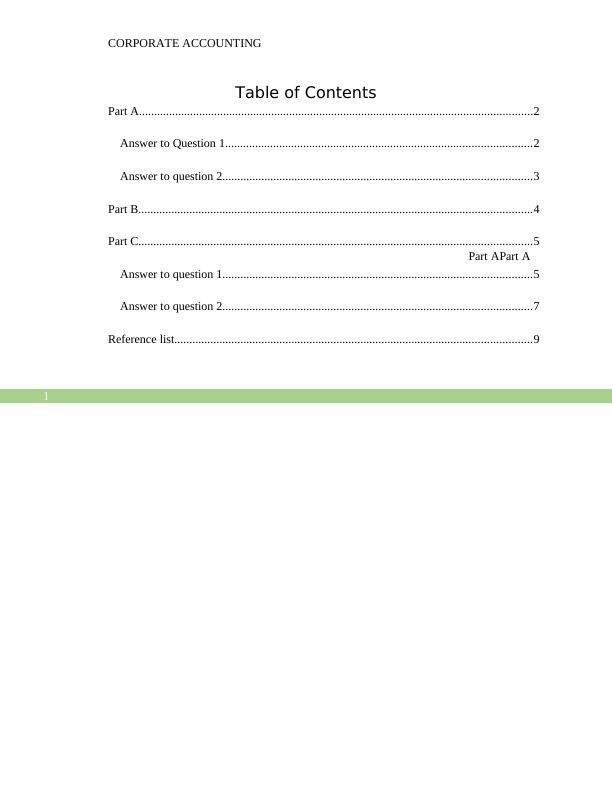Corporate Accounting | Assignment-1
Added on 2022-09-08
11 Pages2086 Words18 Views
Running Head: CORPORATE ACCOUNTING
Corporate accounting
Name of the Student:
Name of the University:
Author note:
Corporate accounting
Name of the Student:
Name of the University:
Author note:

Part APart A
1
CORPORATE ACCOUNTING
Table of Contents
Part A...................................................................................................................................2
Answer to Question 1......................................................................................................2
Answer to question 2.......................................................................................................3
Part B...................................................................................................................................4
Part C...................................................................................................................................5
Answer to question 1.......................................................................................................5
Answer to question 2.......................................................................................................7
Reference list.......................................................................................................................9
1
CORPORATE ACCOUNTING
Table of Contents
Part A...................................................................................................................................2
Answer to Question 1......................................................................................................2
Answer to question 2.......................................................................................................3
Part B...................................................................................................................................4
Part C...................................................................................................................................5
Answer to question 1.......................................................................................................5
Answer to question 2.......................................................................................................7
Reference list.......................................................................................................................9

Part APart A
2
CORPORATE ACCOUNTING
Part A
Answer to Question 1
Carrying amount is the cost of assets or liability, which are recorded in the financial
statement as the net amount after deducting accumulated depreciation, or any impairment cost.
This cost is different from the current market value of the assets or liability as it shows the
market value of the assets or liability depending on the demand and supply of the market. It is
also known as the book value of the assets as the value of the assets are recorded in the books of
account which is calculated as historical cost after deducting accumulated depreciation and the
impairment cost. Its value is calculated by following the GAAP and IFRS accounting principle
(Schaltegger, Etxeberria and Ortas 2017). Carrying value is the measurement of value for the
company’s asset or liability. Usually carrying value is not recorded in the balance sheet and it is
always lower than the current market value. Assets and liabilities are recorded in the balance
sheet in their original cost rather than the market value as it is easy to trace. When a company
purchase any intangible assets then the formula to calculate the carrying amount will be the
original purchase cost minus the amortization expenses. On the other hand if tangible assets is
purchased then the formula to calculate the carrying amount is original purchase cost minus
depreciation.
Carrying amount of the assets is not the same as the market value and it differ in many ways. It
depends on the gradual depreciation of the assets which shows the declined value with the time
pass. The carrying amount of lease assets will reduce more quickly than the carrying amount of
the lease liability because in each period of lease asset the asset value will be depreciating in
straight-line method. The lease liability is reduced by the value of the lease payments which is
increased by the interest, with the reduction of the life of the lease. Amount of the both lease
2
CORPORATE ACCOUNTING
Part A
Answer to Question 1
Carrying amount is the cost of assets or liability, which are recorded in the financial
statement as the net amount after deducting accumulated depreciation, or any impairment cost.
This cost is different from the current market value of the assets or liability as it shows the
market value of the assets or liability depending on the demand and supply of the market. It is
also known as the book value of the assets as the value of the assets are recorded in the books of
account which is calculated as historical cost after deducting accumulated depreciation and the
impairment cost. Its value is calculated by following the GAAP and IFRS accounting principle
(Schaltegger, Etxeberria and Ortas 2017). Carrying value is the measurement of value for the
company’s asset or liability. Usually carrying value is not recorded in the balance sheet and it is
always lower than the current market value. Assets and liabilities are recorded in the balance
sheet in their original cost rather than the market value as it is easy to trace. When a company
purchase any intangible assets then the formula to calculate the carrying amount will be the
original purchase cost minus the amortization expenses. On the other hand if tangible assets is
purchased then the formula to calculate the carrying amount is original purchase cost minus
depreciation.
Carrying amount of the assets is not the same as the market value and it differ in many ways. It
depends on the gradual depreciation of the assets which shows the declined value with the time
pass. The carrying amount of lease assets will reduce more quickly than the carrying amount of
the lease liability because in each period of lease asset the asset value will be depreciating in
straight-line method. The lease liability is reduced by the value of the lease payments which is
increased by the interest, with the reduction of the life of the lease. Amount of the both lease

Part APart A
3
CORPORATE ACCOUNTING
asset and liability are the same in the beginning but the amount of the asset stays lower than the
amount of the liability during the lease period. This effect can be seen in all type of lease of the
company by considering the portfolio effect.
Answer to question 2
New requirement for the lease will be required for the organization who want to report
their lease of both the asset and liabilities on their balance sheet. With the effective adoption of
the new lease accounting standard helps the companies to develop a strategic way for the growth.
New lease are expected to provide the investors and the stakeholders more transparent picture of
the company. This change will make a significant change in the technology, media and
communication industry (Watson 2015).
Every company uses the lease as their only way to obtain the access of the assets so they are
going too effected by the new lease. The new requirement will eliminate all the balance sheet
accounting for the lessee as it is used for the financial metrics. It will affect the credit rating,
borrowing costs and other stakeholders. Lessor business model may be effected as their will be
new need of lease with behavioral change of the lessee. Business process and system are also get
impacted as it requires more data than before. A company has to perform new implementation
like cross-functional approach other than the accounting process. Organization must be prepared
for all potential issues, cost and risk that may arise. Balance sheets of the companies are going to
increase while the gearing ratio will increase and the capital ratio will decreases. Both lessee and
lessor will need to again negotiate and restructure their lease agreement. Business and legal
structure need to reassess with the new lease requirement structure. Lessors are more affected
then the lessor as per the changes required which impacts their business model and the lease
items.
3
CORPORATE ACCOUNTING
asset and liability are the same in the beginning but the amount of the asset stays lower than the
amount of the liability during the lease period. This effect can be seen in all type of lease of the
company by considering the portfolio effect.
Answer to question 2
New requirement for the lease will be required for the organization who want to report
their lease of both the asset and liabilities on their balance sheet. With the effective adoption of
the new lease accounting standard helps the companies to develop a strategic way for the growth.
New lease are expected to provide the investors and the stakeholders more transparent picture of
the company. This change will make a significant change in the technology, media and
communication industry (Watson 2015).
Every company uses the lease as their only way to obtain the access of the assets so they are
going too effected by the new lease. The new requirement will eliminate all the balance sheet
accounting for the lessee as it is used for the financial metrics. It will affect the credit rating,
borrowing costs and other stakeholders. Lessor business model may be effected as their will be
new need of lease with behavioral change of the lessee. Business process and system are also get
impacted as it requires more data than before. A company has to perform new implementation
like cross-functional approach other than the accounting process. Organization must be prepared
for all potential issues, cost and risk that may arise. Balance sheets of the companies are going to
increase while the gearing ratio will increase and the capital ratio will decreases. Both lessee and
lessor will need to again negotiate and restructure their lease agreement. Business and legal
structure need to reassess with the new lease requirement structure. Lessors are more affected
then the lessor as per the changes required which impacts their business model and the lease
items.

End of preview
Want to access all the pages? Upload your documents or become a member.
Related Documents
Company Accounting - Study Material and Solved Assignmentslg...
|8
|1428
|149
Company Accounting: Valuation, Depreciation, Revaluation and Impairmentlg...
|8
|1074
|80
Indicators of Asset Impairment Reportlg...
|10
|1597
|262
Corporate Accounting: Impairment of Fixed Assetslg...
|5
|908
|171
FINANCE AND ACCOUNTING.lg...
|6
|527
|446
Company Accounting ACCT20073 - Deskliblg...
|7
|990
|303